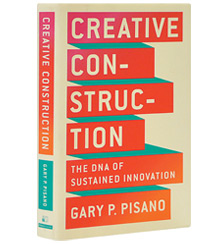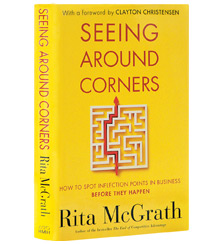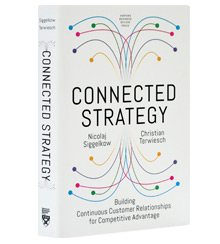Best Business Books 2019: Strategy
Strategy matters.
Gary P. Pisano
Creative Construction: The DNA of Sustained Innovation (PublicAffairs, 2019)
Rita McGrath
Seeing Around Corners: How to Spot Inflection Points in Business Before They Happen (Houghton Mifflin Harcourt, 2019)
*A TOP SHELF PICK
Nicolaj Siggelkow and Christian Terwiesch
Connected Strategy: Building Continuous Customer Relationships for Competitive Advantage (Harvard Business Review Press, 2019)
Leaders of large companies are typically not short on confidence — until it comes to their own strategy. In research conducted by Strategy&, PwC’s strategy consulting group, we find that 65 percent of executives across industries don’t think their company has a winning strategy. And who could blame them? The media and stock market tell us that the biggest incumbents are simply too large to innovate effectively in the face of disruption, that they can’t recognize the oncoming wave until it swamps them. And even if they are able to grasp the existential challenge they face, it is really hard to come up with a holistic functional strategy on the fly.
But this year’s crop of best business books on strategy — vivid, practical, and dynamic — offers solace and inspiration to the denizens of the C-suite. In Creative Construction, Gary P. Pisano, a professor at Harvard Business School, makes a compelling case that large companies can, in fact, thrive in a world of change. In Seeing around Corners, Rita McGrath, a professor at Columbia Business School, describes how leaders can set up early warning systems to detect disruption and get ahead of it. And Connected Strategy, by Nicolaj Siggelkow and Christian Terwiesch, professors at the Wharton School, offers a road map for building strategies that can harness the power of customer interactions. All three provide immersive case studies and emphasize the need for continual experimentation, a strong focus on people, and bold leadership. And they’ll leave readers with the important lesson that corporate strategy is no longer something to be inscribed on stone tablets and slavishly followed, but rather developed through a discovery-driven set of experiments based on curiosity, passion, and analytics.
Too big to succeed?
In an elegantly written and deeply thoughtful book, Gary Pisano tilts against the conventional wisdom that scale is an impediment to innovation. “Big does not always mean ugly,” he writes. And “‘organizational DNA’ is not immutable.” And so, rather than wait for creative destruction to upend their businesses, leaders can create capabilities for transformative innovation. Pisano argues, and shows, that large organizations are not helpless in the wake of nimble, disruptive innovators; indeed, plenty of them have successfully transitioned business models or introduced serial innovations, whether it was IBM developing mainframes in the 1960s or Corning repeatedly rolling out new glass-based products. But too many of these organizations stay on their home court for too long, content to exploit existing resources and capabilities. When opportunities arise, organizations either ignore them or frame the opportunities too narrowly, and don’t focus enough on the problems worth solving.
Creative Construction is divided into three sections. The first focuses on creating strategy; the second describes how to design a system, by searching in “novel and uncertain terrain” and synthesizing results into coherent concepts that can be scaled up; and the third discusses how to build the culture that enables people to engage in such activities with confidence. After all, Pisano writes, “Innovation is a deeply human activity.” Time and again, in fact, Pisano focuses on the way human behavior interacts with strategy. He sets out seven practical ways to encourage people within companies to search out new terrain, such as creating mechanisms that force collaboration and learning from analogies. He cites with approval the culture of an engineering firm that allows for heated yet respectful debates between employees.
Pisano delves into the recent experience of well-known brands that have created disruption (Uber, Apple), those that have been felled by disruption (Blockbuster), and those already giant companies that have managed to engage in creative construction (Monsanto developing genetically modified seeds, Amazon branching out from online retailing to cloud computing services). His categories of innovation — routine, disruptive, radical, and architectural — allow leaders to craft a portfolio of specific, insightful strategies that are more relevant and effective than a generic pure-play innovation strategy. He then articulates a crystal-clear business model framework to help leaders make choices about resources, value creation, value capture, and value distribution (shortened to RV3).
Writing from a position of credibility as a leading academic, company cofounder, consultant, and board member of startups, Pisano describes the reality of pursuing innovation with refreshing honesty, candor, and even humor. He calls out the paradoxes embedded in his approach — such as having a high tolerance for failure while maintaining a low tolerance for incompetence. He recognizes the discomfort likely to ensue. “Creative construction is akin to renovating a house while still living in it,” he writes. And he pithily reminds us that the advice often doled out to leaders of large companies to simply take a cue from their rising competitors is misguided. Demanding that big companies “be more like Uber,” Pisano writes, “is no more realistic than commanding your dog to speak French.” C’est ça!
Trend spotting
One potential way to head off creative destruction is to identify it far enough in advance. In Seeing Around Corners, this year’s best business book on strategy by a slim margin, Rita McGrath has produced an insightful, inspiring, rigorously argued, and comprehensive volume that will become required reading for leaders tackling disruptive opportunities and threats. She focuses on how leaders can spot inflection points and then set up their businesses to benefit when the change comes and new markets materialize. Rather than coming out of nowhere, new trends — the explosive growth in hearing aids (pdf) or digital advertising — in fact develop gradually. And in so doing, they create opportunities, especially for those who adopt a nimble, discovery-driven process. The problem? Companies often have an overly narrow view of the opportunities that lie ahead of them. And many of the indicators leaders rely on to detect changes are lagging indicators; by the time a powerful new trend shows up on your P&L in the form of lower sales, it’s often too late.
McGrath wants to build the capability across organizations to spot inflection points and to mobilize ways to take advantage of them. The key, McGrath argues, is to focus on what customers are doing and what they need, and to take an expansive view of the “arenas” they create, rather than the markets or sectors that currently serve them. The arenas, following the work of Clayton Christensen, are defined by the jobs that need to get done by customers. Retailers focusing on teens need to understand that their arena is now the broad universe, including social media, that competes for the attention of young people. Companies with powerful positions in fossil fuels should grasp that their arena is energy, which is likely to be dominated by renewables.
Once you’ve identified those potential arenas, the hard work starts: coalescing the organization around a strategic path, driven by a single-minded determination and a comfort with ambiguity. McGrath suggests following Tim Brown and Roger Martin’s advice, “throwing out multiple possible strategies and consciously debating them rather than incrementally working from strategies that are already in place.” This means people have to get out from behind their desks and spreadsheets and confront the messiness in the world. Of the eight practices she advocates, two struck me the most. She urges leaders to use creative incentives that reveal useful, if awkward, information and to “talk to the future that is unfolding now.” You can’t see the “snow melting at the edge,” her favorite phrase, if you’re stuck in a corporate ivory tower and dismiss the “alarmists” around you. Railing against traditional command-and-control leadership styles and the strong hierarchies that govern companies, she urges leaders to build networks of people, and challenge them to get involved.
The book is packed with a diverse set of case studies. Although the recent experience of Microsoft thriving in mobile and cloud computing is well known, her framing of the company’s transformation, from focusing on lagging indicators such as sales to focusing on leading indicators such as “customer love,” is compelling. Her discussion of how Netflix was able to see streaming coming around the corner years before the market actually materialized is rich in insight and detail. She reserves her strongest critique for some of the social media networks, especially Facebook. Regardless of their considerable success to date, she argues, the large technology platforms may not recognize the pivots their businesses face because leaders are not paying sufficient attention to their internal alarmists.
Central to the strategy McGrath advocates is to create options for the future without taking big, risky bets. An option buys you the right, not the obligation, to make a choice in the future.
One of the most interesting case studies involves a lesser-known company, the German steel distributor Klöckner & Co. Looking around the corner, its CEO foresaw that the creation of digital platforms could disrupt its business. So it decided to create its own. But rather than try to make a quick digital transition by acquiring a unit and adopting a casual dress code, the company invested in upskilling, and hosted “F—-up nights,” where startup founders who had failed came to discuss their experience. “The program was then extended to allow employees to talk about things that had gone wrong and what they learned,” McGrath writes.
Seeing Around Corners is very well structured. McGrath moves from discussing how to create the necessary flows of information and insight to creating opportunities to taking the actions required in the organization. Her “arena map” is a kind of workbook that allows people to set out today’s assumptions, potential shifts, and future possibilities by resource pool, contestants, stakeholder, consumption chains, experience attributes, and organizational capabilities. Particularly compelling is the use of “time zero events” — a crisp articulation of a specific outcome in the future that could represent the inflection point at the moment it occurs, and then a description of the path to get there (now or in six, 12, or 18 months’ time). Central to the strategy she advocates is to create options for the future without taking big, risky bets. An option buys you the right, not the obligation, to make a choice in the future. “We don’t spend enough time generating new and fresh options, experimenting with them, and learning what they have to teach us,” she writes. My one suggestion is that she could have made more of how technology such as artificial intelligence (AI) can be a powerful enabler of the process she describes.
Rare for a book on corporate strategy, Seeing Around Corners takes a turn near the end toward self-help. McGrath includes a fascinating exercise that asks readers to consider and document their lives, so that they can recognize the patterns that will allow them to see around corners. The same practices, she argues, can enable people to cope with the personal shocks or contingencies they are bound to experience.
Building relationships
Once you recognize that big companies can change and grasp the urgency surrounding inflection points, how do you go about conceptualizing a strategy that will be resistant to disruption in the future? The answer is that you move away from transactions and services and move toward building strong relationships with customers. That’s the argument made by Nicolaj Siggelkow and Christian Terwiesch in Connected Strategy, the most dynamic of the three books. Connected Strategy puts far more emphasis on the power of a customer relationship than many other strategy books. But when you look at the way that customer engagement and commitment fuel such high-performing ecosystem companies as Apple, Amazon, or Peloton, it’s clear why.
The authors start by referencing companies that create more connected and continuous relationships with customers. They don’t want to just fill an immediate need. They want to help customers achieve an outcome they’re passionate about — enjoying a day at a resort, learning a new skill, getting in better shape — and address a wider range of needs, but at a lower cost. The key in all these instances is the use of (often wearable) technology that can improve operational efficiency, facilitate the collation of data, and maintain and build connections to customers. Connected strategies can deliver a better experience, build more loyalty, and generate more revenue at a lower cost (when you’ve got someone hooked on your service, you spend fewer resources marketing it or acquiring new customers).
An unconnected strategy is a taxi company that responds to calls for rides. Now consider a ride-hailing app that made it possible to summon a driver in a new way at a lower cost, and then, once it formed connections, layered on new products and services such as food delivery. The authors set out a powerful and granular articulation of why connected strategies are worth pursuing. There’s a detailed exposition of Nike, which has evolved from selling running shoes to selling runners chip-enabled wellness systems and fitness trackers that can analyze their workouts and link them via a social network to fellow runners.
Building a connected strategy is hard work. It requires a much more agile, dynamic, and responsive organization to deliver on the expectations of the customers they serve. And organizations must develop new capabilities, especially the ability to learn and adjust on a continual basis. The authors describe different types of ecosystems, using familiar examples and calling out five architectures, such as crowd orchestrators and peer-to-peer network creators. Again, the call is not simply to become “Uber but for X.” Instead, Siggelkow and Terwiesch offer a helpful classification of four types of customer experiences: respond-to-desire (Amazon), curated offering (meal-kit company Blue Apron), coach behavior (Nike), and automatic execution (HP sending printer ink replacement cartridges in anticipation of the customer running low).
Of this year’s books, Connected Strategy offers the most comprehensive playbook, full of beautifully presented and packaged frameworks, charts, and call-out boxes. Although grounded in academic research, the prose is very accessible. The book sits alongside a website full of case studies, videos, podcasts (featuring a fascinating group of entrepreneurs, business leaders, and academics), teaching materials, and workshop guides.
Connected Strategy doesn’t delve deeply into the cultural and leadership changes required to enable such a strategy. That may be fertile ground for the authors’ next book, especially given that these changes are challenging for incumbents that haven’t grown up “connected.” But they do discuss the important point that leaders need to make careful choices, even if technology allows them to do more than they should. As they build ecosystems or platforms that derive their power from customer connections, they have to decide how much data to collate, how to anticipate needs while respecting privacy concerns, how much to automate. As customers trust more of their data — and hence more of their personal lives — to companies, sound judgment will be a critical capability.
Reading all, or any, of these books leaves us uplifted about the opportunity for strategy to help organizations serve their customers, shareholders, and employees more effectively, even in the context of considerable change. And when we consider the potential for emerging technologies, especially AI, to improve the quality of scenario building, testing, and improvement, it is the clear the future is bright — perhaps even, for large organizations that are looking around the corner for the next wave of disruption in a world of continuous customer relationships.
Author profile:
- David Lancefield is a strategist and coach who has advised more than 35 CEOs and has led 15 digital transformations. He is a contributing editor of strategy+business, and he also hosts the interview series Lancefield on the Line and publishes the email newsletter Flashes+Sparks. Lancefield was a senior partner with Strategy&, PwC’s strategy consulting business.








